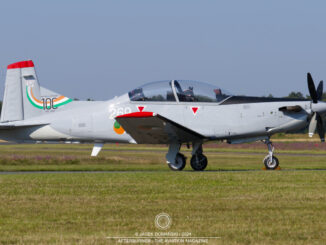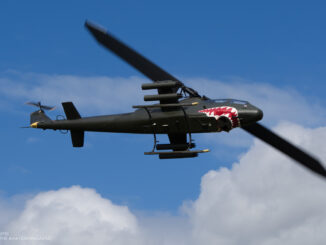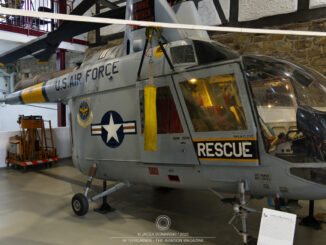 Piaggio P.149 / FWP.149D (c/n 256, D-ELKS, formerly 91+74 of the Luftwaffe), static display during Tag der Bundeswehr, open-door event of the German Armed Forces, Fassberg, June 2024.
Piaggio P.149 / FWP.149D (c/n 256, D-ELKS, formerly 91+74 of the Luftwaffe), static display during Tag der Bundeswehr, open-door event of the German Armed Forces, Fassberg, June 2024.
History of the P.149 light training aircraft dates back to the mid-1940s and development of Fokker Instructor. It was a single-engine, two seat elementary training aircraft, as well as one of the first Fokker designs created after the World War II. The aeroplane was made in two main variants, S-11 taildragger and S-12 with tricycle landing gear.
In the early 1950s, Piaggio Aero purchased rights to manufacture and modify of the S-11 trainer. The Italian company planned to redevelop the aircraft and then introduce it into the market as modern alternative for still popular surplus light military aircraft from the war production.
The task to redesign the Dutch aircraft was assigned to Giovanni Casiraghi. He created a light, all-metal monoplane with tricycle landing gear. The aeroplane was officially designed P.148 but quickly, due to its compact size, was commonly named ´Piaggino´.
On 12th February 1951, the P.148 performed its maiden flight. After a short testing period, ´Piaggino´ was approved for serial production. Approximately one hundred examples of the aircraft were made, with seventy purchased by the Italian Air Force.
Although the P.148 was designed for initial flight training, the aeroplane was also able to perform aerobatics, as well as for instruments-only and night flights. Nevertheless, the Italian Air Force initially used ´Piaggino´ for liaison duties and glider towing, as the piston-powered aeroplane seemed redundant in the jet pilot training programme. It shortly was proved a wrong conviction and, in the late 1960s, the P.148 was eventually assigned to military flight schools in a wider scope.
However, the initial service of the P.148 and much wider range of duties the aircraft was assigned with the Italian Air Force, prompted Piaggio to develop a four-seat, utility variant of the aeroplane. Its maiden flight took place on 19th June 1953.
The new version of the aircraft was designated P.149 and was marketed as touring and liaison aircraft which was also suitable for aerobatics. However, there were just a few examples sold initially and it seemed there is almost no interest in the four-seat version of ´Piaggino´.
Fortunately for Piaggio, the situation soon changed with an order received from Bundeswehr. The German Armed Forces selected the P.149 as their new liaison and training aeroplane. Deliveries began in 1957 and the German Air Force acquired seventy-six examples of the aircraft. Then, the production was moved to Germany where another 190 aircraft were made under license by Focke-Wulf (as FWP.149D).
The Bundeswehr took over almost all of the manufactured P.149s. Only about a dozen examples were sold to other operators, including the Italian, Israeli, Nigerian and Ugandan air forces.
The P.149, nicknamed ´Piggi´, remained in German service until 1990. The aircraft was used in different stages of the pilots´ training, including the initial selection, basic aerobatics, instrument flights and flying in severe weather conditions. The P.149 was also used as aerobatic display aircraft.
The aeroplane pictured within our Photo of the Week series was initially operated by Luftwaffe training centres in Memmingen and Uetersen. In the late 1970s, that P.149 was retired from active service and sold to private operator.
In May of 2006, the ´Piggi´ was acquired by RK Flugdienst (Die Reservistenkameradschaft Flugdienst) association. The P.149 was then renovated into its original condition and approved for flying operations.
The aircraft received a livery of solo display aeroplane of Flugzeugführerschule „S” (Pilot School S) from the early 1960s, as well as fictional tactical number following the early German military identification system used until 1967.



